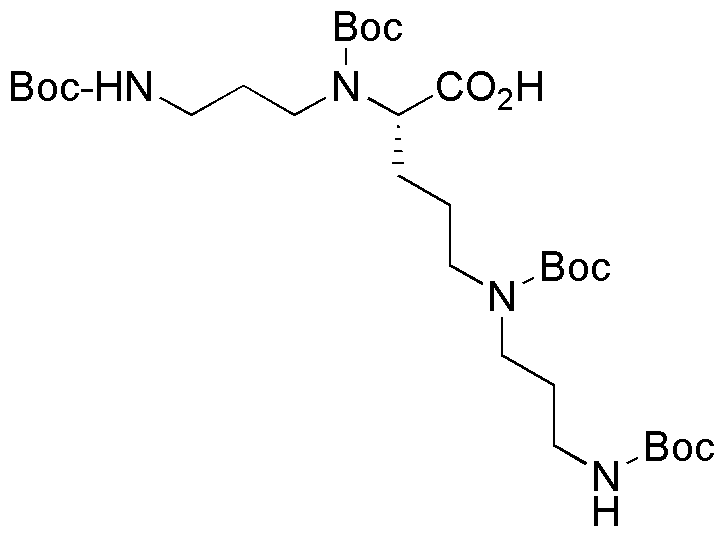tetra-Boc-spermine-5-carboxylic acid is widely utilized in research focused on:
- Bioconjugation: This compound serves as a versatile linker in bioconjugation processes, allowing researchers to attach biomolecules like proteins or antibodies to surfaces or other molecules, enhancing drug delivery systems.
- Gene Delivery: Its unique structure makes it effective in formulating non-viral vectors for gene delivery, which is crucial in gene therapy applications, providing a safer alternative to viral methods.
- Polymer Chemistry: The compound is used in the synthesis of functionalized polymers, which can be applied in drug delivery and tissue engineering, offering tailored properties for specific biomedical applications.
- Analytical Chemistry: It acts as a derivatizing agent in analytical techniques, improving the detection and quantification of amino acids and other biomolecules in complex mixtures.
- Pharmaceutical Development: Its role in modifying drug properties, such as solubility and stability, makes it valuable in the formulation of new pharmaceutical compounds, potentially leading to more effective medications.
General Information
Properties
Safety and Regulations
Applications
tetra-Boc-spermine-5-carboxylic acid is widely utilized in research focused on:
- Bioconjugation: This compound serves as a versatile linker in bioconjugation processes, allowing researchers to attach biomolecules like proteins or antibodies to surfaces or other molecules, enhancing drug delivery systems.
- Gene Delivery: Its unique structure makes it effective in formulating non-viral vectors for gene delivery, which is crucial in gene therapy applications, providing a safer alternative to viral methods.
- Polymer Chemistry: The compound is used in the synthesis of functionalized polymers, which can be applied in drug delivery and tissue engineering, offering tailored properties for specific biomedical applications.
- Analytical Chemistry: It acts as a derivatizing agent in analytical techniques, improving the detection and quantification of amino acids and other biomolecules in complex mixtures.
- Pharmaceutical Development: Its role in modifying drug properties, such as solubility and stability, makes it valuable in the formulation of new pharmaceutical compounds, potentially leading to more effective medications.
Documents
Safety Data Sheets (SDS)
The SDS provides comprehensive safety information on handling, storage, and disposal of the product.
Product Specification (PS)
The PS provides a comprehensive breakdown of the product’s properties, including chemical composition, physical state, purity, and storage requirements. It also details acceptable quality ranges and the product's intended applications.
Certificates of Analysis (COA)
Search for Certificates of Analysis (COA) by entering the products Lot Number. Lot and Batch Numbers can be found on a product’s label following the words ‘Lot’ or ‘Batch’.
Numéro de catalogue
Numéro de lot/série
Certificates Of Origin (COO)
This COO confirms the country where the product was manufactured, and also details the materials and components used in it and whether it is derived from natural, synthetic, or other specific sources. This certificate may be required for customs, trade, and regulatory compliance.
Numéro de catalogue
Numéro de lot/série
Safety Data Sheets (SDS)
The SDS provides comprehensive safety information on handling, storage, and disposal of the product.
DownloadProduct Specification (PS)
The PS provides a comprehensive breakdown of the product’s properties, including chemical composition, physical state, purity, and storage requirements. It also details acceptable quality ranges and the product's intended applications.
DownloadCertificates of Analysis (COA)
Search for Certificates of Analysis (COA) by entering the products Lot Number. Lot and Batch Numbers can be found on a product’s label following the words ‘Lot’ or ‘Batch’.
Numéro de catalogue
Numéro de lot/série
Certificates Of Origin (COO)
This COO confirms the country where the product was manufactured, and also details the materials and components used in it and whether it is derived from natural, synthetic, or other specific sources. This certificate may be required for customs, trade, and regulatory compliance.


